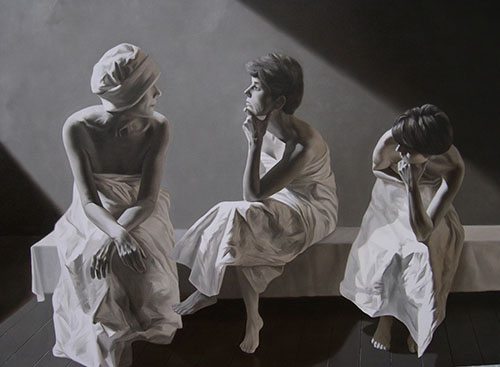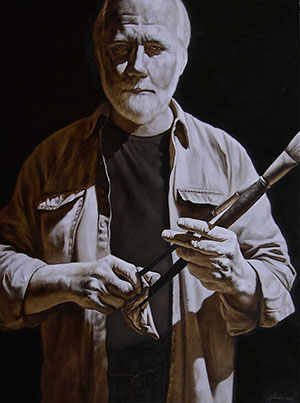— by Lin McNulty —

Three Women On A Bench
Terry Johnson refers to himself as a painter, rather than the term artist that those viewing his works would naturally apply to his skills. He considers “artist” to be an abused term and being a painter simply means one who is trying to be an artist.

Artist Cleaning Brushes, a self portrait.
Introspective and soft-spoken, Johnson “somehow discovered” in high school that he could draw; he experienced joy in this natural talent and found comfort in the solo endeavor where he didn’t have to rely on personality. As he came to be recognized for this ability, painting signs and posters for local townspeople, he began to ponder a potential beyond the small town and a disinterested family. He remembers thinking that “something’s got to be better than this.” His ability to draw was his ticket out of the small Minnesota town of 300 people when he became the first person in his family to attend college.
Following graduation from St. Cloud College where his talent and ability was further encouraged, he was accepted as a graduate student at the University of Washington (UW) with a two-year, free ride scholarship. It was a long way from Minnesota, he says, which was the main attraction, but it was the mountains and the sea drew him to the west coast.
At a UW grad school student art show, he was offered a position, on the spot, at Seattle’s Cornish College of the Arts where he taught for 22 years. He has been the recipient of numerous grants and fellowships and his works have been exhibited in major galleries and museums across the country.
In 2003 he moved to Orcas Island where a group of eager painters welcomed his weekly classes at Orcas Center. He continues to teach weekly in the Madrona Room at Orcas Center and has tutored and mentored some 50 students; many continue in his classes years later, continuing to learn that every painter must first learn how to draw.
His favorite medium is oil because of its ability to forgive. His monochromatic works are all about light, tonality, and the illusion of space. And his motivational muse is personal trauma, and pivotal points in life. His process is “convoluted, personal, and individual,” he says. He used to fear that his students would use his techniques, but he has, in later years, become more willing to share his skills and knowledge with his students.
He “builds” his paintings, waiting for all the elements to come together as art. He is quick to point out that the art doesn’t always happen; he does not consider every one of his pieces as art. He will sometimes go back to a work after a couple of years to resurrect it and make changes.
In his spare time, he is a voracious reader, especially topics involving science. And he finds great joy in demonstrating a technique and seeing his students light up, indicating they “get it.” His favorite artist? With absolutely no hesitation he says it is Rembrandt, hands down. Even after 400 years, he relates wistfully, you can still see Rembrandt’s “hand” on the canvas, the swishes, the brush strokes, the movement.
Johnson will be opening an annual show of his students’ works at Orcas Center this coming Friday, Jun. 9. More of his work may be viewed at his website: www.terryjohnsonprof.com.
**If you are reading theOrcasonian for free, thank your fellow islanders. If you would like to support theOrcasonian CLICK HERE to set your modestly-priced, voluntary subscription. Otherwise, no worries; we’re happy to share with you.**









The correct date for Terry Johnson’s class show is June 9 which is a Friday.
Hope to see you there.
Mary Anne
HS!- Lin: Had to read through to see that Terry is truly a person/artist of interest, and not a “person of interest.” (Thank you to our current politics.)
Just wrote re his opening at Orcas Center on our sandwich board at Chamber office and at Farmers Market. See you at the opening. Rick Markov, Board
Terry is both a great artist and a great teacher. That is really difficult to find if you are a painting student. I have taken classes from Terry for about 8 years and find his instruction consistent, clear, and inspiring. My skills and knowledge have continued to grow with his encouragement. Thank you, Terry!